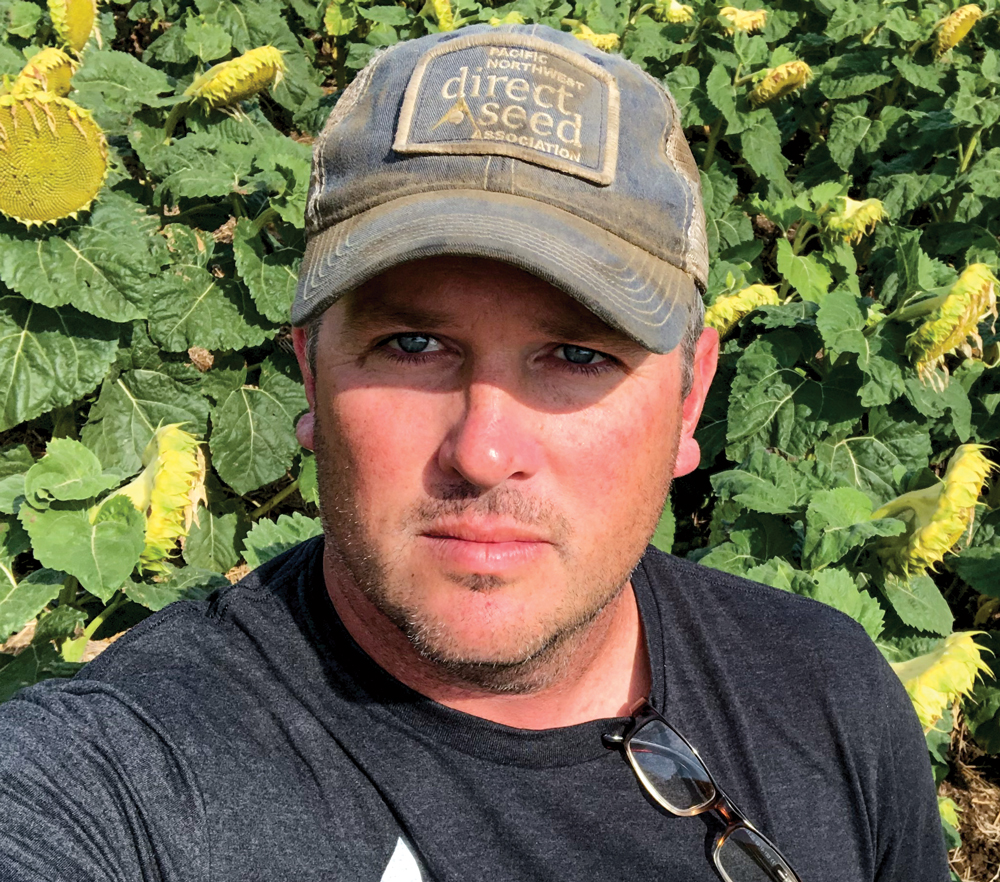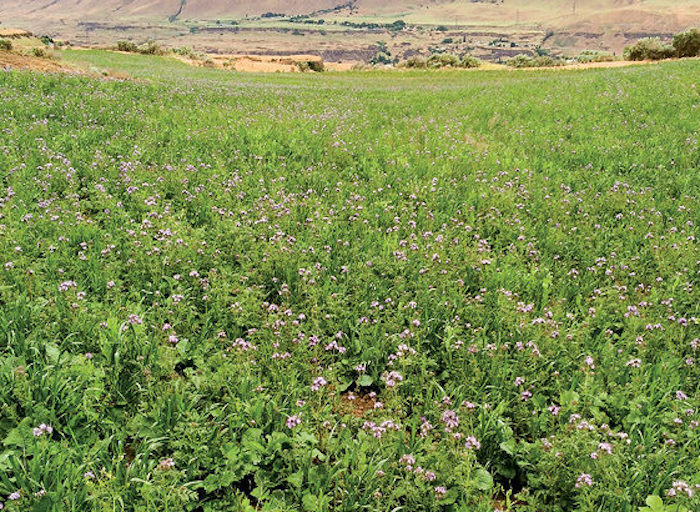Pictured Above: FARMER IN THE DALLES. Farming in The Dalles, Ore., where just 10-12 inches of rain falls each year, Noah Williams used soil moisture sensors to show that growing a cover crop for 60 days (30 days growing, 30 days grazing) uses the same amount of moisture as is lost to evaporation in chem fallow during the same period.
FARMERS WANT TO see a profit. They want to see it every year and with every crop. There’s nothing wrong with that exactly, but I want to consider long term potential benefits and compounding profits as much as short-term gain when weighing management strategies.
I stumbled into no-till because I was playing the crop insurance game and it was the cheapest way to get a crop in the ground. Battling a 5-year drought and going broke fast, the short-term gain of going no-till won out due to it being the more affordable management practice. Long-term gain just happened to follow along with it.
It proved an especially good decision as I let marginal flat land go and started farming the 10-45-degree slopes near The Dalles, Ore., overlooking the Columbia River. No-till helped me rein in erosion and, with the help of chem fallow, win the battle against the morning glory that had flourished with tillage. Winter wheat yields jumped from a 48-bushel average to a 73-bushel average.
Today I know that making decisions that earn me at least some profit, even if it’s small, every year are better than decisions that yield one huge year of profit followed by a year, or years, of losses.

Check The Specs...
NAME: Noah Williams
FARM: Williams Ranch
LOCATION: Wasco, Ore.
YEARS NO-TILLING: 18
ACRES: 2,700
CROPS: Winter wheat, spring barley, spring wheat, sunflowers, forage cover crops
I could write a huge check for fertilizer this year, make no changes and still be writing that same check 10 years from now. Or I can start making changes today that will result in that expense being reduced, or even eliminated in the future.
Those changes may not yield big profits the first, second, or even third year. However, the incremental investment in practices, such as adding crop diversity, growing cover crops and adding livestock, will hopefully build on each other to provide long-term, consistent and increasing profits.
Diving Into Diversity
Our area’s traditional “rotation” is winter wheat-fallow-winter wheat-fallow. The overwhelming majority of farmers still follow that plan and I was one of them up to 2014. Then I attended a Pacific Northwest Direct Seed Association conference that was held in conjunction with the Washington Oilseeds conference. Talks about soil health and cropping diversity caught my attention.
In spring 2014 I tried three different cover crop mixes — a winter mix, a cool season spring mix, a warm season spring mix — plus a check on 20 acres. We didn’t have any diversity, just endless grass on grass on grass. It wasn’t much of a risk as I seeded it on chem fallow acres and didn’t have to worry about a crop failure as the plan was to terminate it anyway.
NO-TILL TAKEAWAYS
- Cover crops, grazing and adding sunflowers to the rotation can reduce compaction and improve overall soil structure.
- Proving practices on your own acres can lead to landlords being more receptive to embracing change.
- Biosolid applications provide all N, P and micronutrients needed for the crop along with microorganisms to benefit the soil.
When the winter wheat was harvested on those acres the following year, it showed yields improved on poor ground where cover crops grew. The higher yielding ground didn’t show much change at all, but the improvement on the low-yielding areas was dramatic.
The next year I seeded 100 acres and intensively grazed 60 acres. My neighbor put 60 head of yearlings on the cover crop mix. They gained on average 3-4 pounds per day.
I didn’t see dramatic yield increase when I grazed the cover crops but leasing out the grazing paid for the seed. They managed the residue and took the nutrients the cover crop roots mined from the soil and deposited them on the surface along with microorganisms from their gut biome, saliva and urine.
Seeing the benefits of this system requires some long-term thinking. I can cover the cost of the program with grazing and there is work out there that shows bringing livestock back to the farm helps revive the soil which can result in reduced inputs over time.
I have some evidence this should prove up. I use biosolids from a nearby wastewater treatment facility to fertilize some of my acres. After going through the anaerobic digester, the sludge and all the beneficial microbes in it are applied in place of synthetic fertilizer.
The solution is 98% water with just 2-3% biosolids and is applied at 7,000-9,000 gallons per acre. It provides all the nitrogen (N) and phosphorus (P) the crop needs plus micronutrients. The wheat is always greener where the biosolids were applied than with synthetic fertilizer, and I think that has to do with microbial activity. I think we’ll get similar long-term results from the microbial activity that begins in the rumens of our grazing cattle.
In 2020, the field that had biosolids produced 90-bushel winter wheat. A field with slightly less potential that received only synthetic fertilizer produced just 64 bushels. That’s a significant difference.
The cattle also see a benefit in getting a full nutrient package through their food. When grazing the lush cover crops they require less water and no minerals. In 2020, the cattle came from grazing dry, low-feed-value rye and were going through minerals like crazy. I told the owners they wouldn’t need mineral tubs for the cattle when they were grazing the cover crop, but they put it out anyway. They had to haul it all back out when they took the cattle. Everything they needed was in those plants.
Moisture Tightrope
In an area that sees just 10-12 inches of rainfall, most of which comes in the winter, it’s essential to bank every drop of moisture. That’s why summer fallow is popular here. That’s also why it can be a bit anxiety inducing to seed a cover crop on those acres that are supposed to be resting and recharging soil moisture stores.
I plant anywhere from 100 to just over 200 acres of cover crop on my chem fallow fields. Any volunteer plants are burned down with the normal Roundup application in March or April. Cover crops are planted directly after and allowed to grow for roughly 60 days.
Soil moisture sensors help me manage my cover crops and prove they’re doing no harm in my system. The data shows I lose the same amount of moisture to evaporation in chem fallow as I do to growing cover crops — for approximately 60 days.
Sensors detect moisture from 6 inches to 3 feet deep. We only ever use moisture in the 6-inch band in that 60-day period. Spring rain usually recharges the moisture used from the topsoil and the cover crops improve the soil to make it even easier for the rain to be captured and moved deeper into the soil profile.
In chem fallow there tends to be a compaction layer acting like a barrier against water infiltration. When I did a compaction test it took 300-400 psi of pressure to penetrate soils in traditional chem fallow fields. After just one year of cover crops, it took half the pressure at just 200 psi.
That tells me I’m opening up the soil, making it more like a sponge instead of a rock. When the moisture is able to wick deeper into the ground stores, it’s not as vulnerable to evaporation.
Warm season cover crop mixes tend to have the greatest impact on soil structure. In a climate that favors cool-season plants, though, they are slower growing and can be difficult to get established.
Sorghum-sudangrass, for example, hits its stride when soil temperatures hit 70 F. That’s about when I want to be terminating the cover crop. I’ve had to adjust mixes to find what works for soils, what the cattle like and what I can grow. It’s constantly changing.
Mixes often include triticale, oats or barley, phacelia (I always like to have a pollinator in the mix), Austrian winter peas, hairy vetch, forage collards, turnips, safflower and sunflowers. I use traditional safflower in my grazing mix. When it’s young and tender the cows will graze it, but once it matures a bit they leave it alone. This suits me because I don’t want the cows to eat everything. I want some cover and structure for the soil.
In spring 2020, I subbed straight barley in for triticale and oats in the mix. It was a better forage for the cows and still gave good soil health benefits. I’ve swapped forage collards for radishes in my mix. They put down a similar root system, but don’t put on seed as fast. Radishes put on seed quickly and become a problem. Oats can also be concerning as our main crop is wheat. We want to be able to graze it hard and fast enough that it doesn’t make seed.
My current program is to let the cover crop grow 30 days then graze it for 30 days. I try to push the grazing days a little longer to get more grazing benefit. However, if I see moisture levels dropping or plants starting to set seed, I have the backup plan of terminating the cover crop.
Fleeting Flower, Lasting Impact
A neighbor who grew sunflowers gave me the courage to experiment with them myself. They are certainly not a crop you see in this area, but I thought they might not only add beneficial diversity, but help with my residue issue.
Our 70-bushel wheat crop produces as much stubble as a 100-bushel crop in the Midwest. I don’t know why, it just seems to. It’s a lot of tough residue to manage.
“I lose the same amount of moisture to evaporation in chem fallow as I do to growing cover crops for approximately 60 days…” – Noah Williams
I farm up to 45-degree slopes and the wind blows 20-30 mph nearly constantly. It’s good to have protection for the soil, but with our lack of humidity, I end up struggling to direct seed into 2 years of crop residue.
When I first started no-till I used a Concord hoe drill. It would plug up horribly on the thick residue and, after the frustrating job of cleaning it out, would leave behind piles of residue we affectionately call “gut piles.”
Sunflowers produce much less residue, and break lifecycles of nematodes that harm our wheat. It was worth a shot. In 2018, I seeded 50 acres. I was advised not to seed until May to avoid frost. But April is usually frost free for me and by May moisture is starting to drop already. I planted in May and was saved by a freak storm that provided enough moisture for the crop to germinate.
In this first experiment I harvested 70-bushel winter wheat in spring 2017, then seeded sunflowers in place of summer fallow the following year. When I harvested them in fall 2018, they yielded 812 pounds to the acre, which is profitable. Then in 2019 I planted spring barley that yielded 1 ton (42 bushel) per acre.
None of those were bumper crops, but I got three crops in three years, each one profitable. On the fourth year I put the ground back to chem fallow.
The sunflowers had a profound effect on soil structure, mellowing it significantly. With that in mind, I planted 150 acres of sunflowers on my worst ground in 2019. Yields ranged from 1,800 pounds down to 600 pounds in a re-crop situation. That averages out to 850 pounds per acre and, again, was profitable. I do spend less on seed than those in the Dakotas and see less yield. I seed for just 14,000-16,000 plants per acre as I don’t get as much rain as the guys in the Dakotas who are planting populations of 22,000-30,000.
Sunflowers have proven profitable, and I want the warm season crop for diversity. So far, the key seems to be to get them in the rotation once every three years. I would like to try more crops I can grow in succession, but I have to find the right crop. Another neighbor is trying winter canola, so I’m keeping my eye on how it works out for him.
Equipment Shift
With changing crops comes changing equipment. In 2018, I moved from a hoe-style no-till drill to a Pillar disc/hoe hybrid no-till drill. There’s more cost to running a disc drill, and it’s not a “set and forget” piece of equipment, but it allows me to better seed more diverse crops and seems to really shine in my spring crops especially.
It’s a very heavy drill, weighing 30,000 pounds for just the toolbar itself before we add seed. I learned it needed to be adjusted by soil type as it would plant ¼-inch deep in a field with heavy soils and bury itself to 1½-inches deep in lighter soils at the same setting.
The Pillar drill has a disc and a carbide wing off to the side. The disc cuts a trench to deep-band liquid 32% nitrogen (N) while the wing deposits the seed and a dry starter fertilizer in the trench sidewall 1½-inches to the side of the fertilizer band.
T-Jet electric motors controlled with an Ag Leader system run the seed and fertilizer meters to allow for variable rate applications of both. The electric motors allow for greater accuracy at lower speeds than hydraulic controls.
The wing acts like a mud scraper, which is why I think it works so well for my spring crops. It also maintains a more consistent depth than the hoe drill, which is more critical for seeding sunflowers.
The Pillar drill disturbs less soil, leaving less roughed up dark surface to gather sunlight. The soils stay colder longer than with the hoe drill, especially on the northern slopes. The first year I used it, some of my winter wheat really didn’t want to come up. When I seeded in fall 2019, I set the drill to a shallower depth and that seemed to work well.
Proving Up
I rent a good portion of my farm ground. Selling landlords on some of the things I want to do, like cover crops or adding sunflowers to the rotation, can be tough.
I can show them all the data I want, but unless they see it in action, they’re not often open to deviating from the comfort of tradition. They don’t want to take the risk of a reduced income if the experiment doesn’t pan out.
As a result, I use the acres I own to prove out my ideas. All the information and progress reports are posted on my Williams Ranch Facebook page.
Landlords can watch my successes (or failures) and gain confidence in what I suggest. One of my landlords even approached me about growing sunflowers on their place after they saw the benefits it had on my acres.
They may still not look to the long term, which is why the biggest innovations will happen on my own acres. I see the potential to eliminate fallow entirely.
In a winter wheat-fallow rotation, gross profits are $1,000 per acre in a 4-year period. When I added sunflowers to my rotation with spring grains, I planted three crops in four years, gained soil health benefits and earned $900-1,000 per acre gross profits. On my own land I get to keep all the profits, so if I can make even $150-300 per acre gross profit on my rotation crops I stand to come out significantly ahead in the long run.








Post a comment
Report Abusive Comment